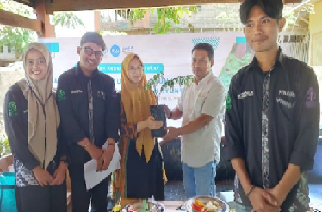Family empowerment strategy and stunting prevention through moringa tree planting movement
Abstract
Stunting is a significant global health problem, with an estimated 149 million children under five experiencing this condition in 2018. Moringa is a nutrient-rich plant recommended by WHO as an alternative food to overcome nutritional problems or malnutrition. This service aims to increase knowledge about the use of moringa to prevent stunting, encourage active community participation in planting moringa trees in every home, and hone family skills in innovation in processing moringa-based food. The service method uses a Participatory Action Research (PAR) approach. This program is conducted through education, training, and mentoring using lecture, discussion, and direct practice methods. The results of the service showed a positive response from the community, as seen from their activeness during education and socialization of Moringa-based food innovations. This education succeeded in increasing public understanding about using Moringa leaves to prevent stunting, with pre-test and post-test data showing an increase in knowledge from 44.60 to 93.00. This program also distributed 500 Moringa tree seeds and trained people to make processed Moringa products into innovative foods, such as pudding and brownies, opening up economic opportunities. This program is expected to provide sustainable benefits for the health and welfare of the local economy.
References
Alam, S., Rusmin, M., Aswadi, A., & Syafri, M. (2024). the Role of Human Development Cadres in Efforts To Prevent Stunting. Hospital Management Studies Journal, 5(1), 52–71. https://doi.org/10.24252/hmsj.v5i1.43689
Anita, S., Novita, N., & Vasra, E. (2023). Factors Associated with Stunting Incidents in Toddlers. 3(June), 287–294. https://doi.org/10.36086/maternalandchild.v3i1.1671
Arifin, A.S., Ardan, Hakim, R.N., Rahmadani, S., Ibrahim, J.A., Khatima, K., Cahyaningsih, R., Bafadal, U., Wahyuliani, E., Nugraha, T., & Zulfah, A. (2024). Pemanfaatan Olahan Daun Kelor untuk Menekan Angka Stunting di Kelurahan Limbangan Wetan. Jurnal Pengabdian Masyarakat Indonesia, 4(1):41-47. https://doi.org/10.52436/1.jpmi.1949
Basri, H., Hadju, V., Zulkifli, A., Syam, A., & Indriasari, R. (2021). Effect of moringa oleifera supplementation during pregnancy on the prevention of stunted growth in children between the ages of 36 to 42 months. Journal of Public Health Research, 10(2). https://doi.org/10.4081/jphr.2021.2207
Chiu, B., Olson, M., & Fahey, J. (2021). Exploring the use of moringa oleifera as a vegetable in agua caliente nueva, jalisco, mexico: a qualitative study. Food Frontiers, 2(3), 294-304. https://doi.org/10.1002/fft2.103
Davidson, S. M., Mangalik, G., Tauho, K. D., & Afriani, A. (2023). Pelatihan Dapur Sehat Atasi Stunting di Lokasi Fokus ( Lokus ) Penanganan Stunting Kabupaten Boyolali. 5(2), 331–336. https://doi.org/10.36565/jak.v5i2.522
Elgendy, M., Awad, E., Darwish, D., Ibrahim, T., Soliman, W., Kenawy, A., & Abbas, W. (2021). Investigations on the influence of moringa oleifera on the growth, haematology, immunity and disease resistance in oreochromis niloticus with special reference to the analysis of antioxidant activities by page electrophoresis. Aquaculture Research, 52(10), 4983-4995. https://doi.org/10.1111/are.15370
Gambo, A., Moodley, I., Babashani, M., Babalola, T., & Gqaleni, N. (2021). A double-blind, randomized controlled trial to examine the effect of moringa oleifera leaf powder supplementation on the immune status and anthropometric parameters of adult hiv patients on antiretroviral therapy in a resource-limited setting. Plos One, 16(12), e0261935. https://doi.org/10.1371/journal.pone.0261935
Hadju, V., Dassir, M., Sadapotto, A., Putranto, A., Marks, G., & Arundhana, A. (2020). Effects of moringa oleifera leaves and honey supplementation during pregnancy on mothers and newborns: a review of the current evidence. Open Access Macedonian Journal of Medical Sciences, 8(F), 208-214. https://doi.org/10.3889/oamjms.2020.4670
Khan, A. and Ali, Q. (2023). Moringa - the miracle tree: an overview of its nutritional and medicinal properties. Asian Journal of Biochemistry Genetics and Molecular Biology, 15(3), 32-44. https://doi.org/10.9734/ajbgmb/2023/v15i3337
Khofifah, N., & Mardiana. (2023). Biskuit daun kelor (Moringa oleifera) berpengaruh terhadap kadar hemoglobin pada remaja putri yang anemia. AcTion: Aceh Nutrition Journal, 8(1):43-50. https://doi.org/10.30867/action.v8i1.614
Maria, I., Nurjannah, N., Mudatsir, Bakhtiar, & Usman, S. (2020). Analisis Determinan Stunting Menurut Wilayah Geografi Di Indonesia Tahun 2018. Majalah Kesehatan, 7.
Mulyaningsih, T., Mohanty, I., Widyaningsih, V., Gebremedhin, T. A., Miranti, R., & Wiyono, V. H. (2021). Beyond personal factors: Multilevel determinants of childhood stunting in Indonesia. PLoS ONE, 16 (11 November), 1–19. https://doi.org/10.1371/journal.pone.0260265
Musaidah, M., Syam, A., Wahyu, A., Hadju, V., Sudargo, T., Abdullah, A., & Syukur, R. (2022). The influence of giving biscuits of yellow pumpkin seed and capsule of moringa leaves on the level of c-reactive protein on pregnant women. International Journal of Design & Nature and Ecodynamics, 17(4), 627-632. https://doi.org/10.18280/ijdne.170419
Perwitasari, T., & Nurita, S. R. (2023). Edukasi pada Ibu Balita tentang Pemanfaatan Daun Kelor untuk Pencegahan Stunting di Desa Talang Bukit Muaro Jambi. 5(2), 230–234. https://doi.org/10.36565/jak.v5i2.458
Pilotos, J., Ibrahim, K., Mowa, C., & Opata, M. (2020). Moringa oleifera treatment increases tbet expression in cd4+ t cells and remediates immune defects of malnutrition in plasmodium chabaudi-infected mice. Malaria Journal, 19(1). https://doi.org/10.1186/s12936-020-3129-8
Pitoyo, A. J., Saputri, A., Agustina, R. E., & Handayani, T. (2022). Analysis of Determinan of Stunting Prevalence among Stunted Toddlers in Indonesia. 30(1), 36–49.
Rohmawati, N., Moelyaningrum, A. D., & Witcahyo, E. (2019). Es Krim Kelor : Produk Inovasi Sebagai Upaya Pecegahan Stunting Dalam 1000 Hari Pertama Kehidupan (HPK). Jurnal Pengabdian Masyarakat, 2:1–88.
Salihu, F., Salihu, M., & Nyadar, P. (2024). Proximate analysis and nutritional content of moringa oleifera leaves collected from horticultural garden in gwagwalada, federal capital territory, abuja, nigeria. jasem, 28(4), 1267-1272. https://doi.org/10.4314/jasem.v28i4.27
Sembiring, R., Panduragan, S., Natarajan, S., Poddar, R., Purba, A., Syapitri, H., & Sinaga, T. (2023). Improvement of toddler weight with giving of moringa leaf extract biscuit (moringa oleifera). Malaysian Journal of Medicine and Health Sciences, 19(s9), 140-145. https://doi.org/10.47836/mjmhs.19.s9.21

Copyright (c) 2025 Nur Rahmah, Syamsul Alam, Zilfadhilah Arranury, Muhammad Kahfi

This work is licensed under a Creative Commons Attribution-NonCommercial-ShareAlike 4.0 International License.
